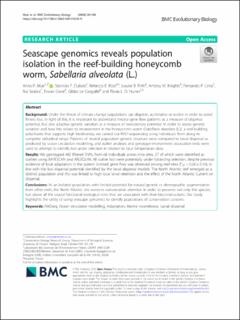Seascape genomics reveals population isolation in the reef-building honeycomb worm, Sabellaria alveolata (L.)
| dc.contributor.author | Muir, Anna P. | |
| dc.contributor.author | Dubois, Stanislas F. | |
| dc.contributor.author | Ross, Rebecca | |
| dc.contributor.author | Firth, Louise B. | |
| dc.contributor.author | Knights, Antony M. | |
| dc.contributor.author | Lima, Fernando P. | |
| dc.contributor.author | Seabra, Rui | |
| dc.contributor.author | Corre, Erwan | |
| dc.contributor.author | Le Corguillé, Gildas | |
| dc.contributor.author | Nunes, Flavia L.D. | |
| dc.date.accessioned | 2020-10-22T12:57:47Z | |
| dc.date.available | 2020-10-22T12:57:47Z | |
| dc.date.created | 2020-08-12T15:13:05Z | |
| dc.date.issued | 2020 | |
| dc.identifier.issn | 1471-2148 | |
| dc.identifier.uri | https://hdl.handle.net/11250/2684558 | |
| dc.description.abstract | Under the threat of climate change populations can disperse, acclimatise or evolve in order to avoid fitness loss. In light of this, it is important to understand neutral gene flow patterns as a measure of dispersal potential, but also adaptive genetic variation as a measure of evolutionary potential. In order to assess genetic variation and how this relates to environment in the honeycomb worm (Sabellaria alveolata (L.)), a reef-building polychaete that supports high biodiversity, we carried out RAD sequencing using individuals from along its complete latitudinal range. Patterns of neutral population genetic structure were compared to larval dispersal as predicted by ocean circulation modelling, and outlier analyses and genotype-environment association tests were used to attempt to identify loci under selection in relation to local temperature data. | en_US |
| dc.language.iso | eng | en_US |
| dc.title | Seascape genomics reveals population isolation in the reef-building honeycomb worm, Sabellaria alveolata (L.) | en_US |
| dc.type | Peer reviewed | en_US |
| dc.type | Journal article | en_US |
| dc.description.version | publishedVersion | en_US |
| dc.source.volume | 20 | en_US |
| dc.source.journal | BMC Evolutionary Biology | en_US |
| dc.identifier.doi | 10.1186/s12862-020-01658-9 | |
| dc.identifier.cristin | 1823021 | |
| cristin.ispublished | true | |
| cristin.fulltext | original | |
| cristin.qualitycode | 2 |
Tilhørende fil(er)
Denne innførselen finnes i følgende samling(er)
-
Articles [3012]
-
Publikasjoner fra CRIStin [3070]
